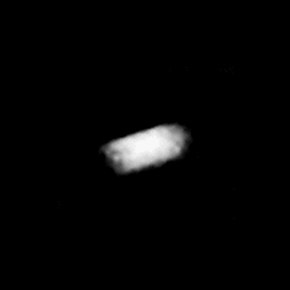Galatea /ɡæləˈtiːə/, also known as Neptune VI, is the fourth-closest inner moonofNeptune. It is named after Galatea, one of the fifty NereidsofGreek legend, with whom Cyclops Polyphemus was vainly in love.

| |
| Discovery | |
|---|---|
| Discovered by | Stephen P. Synnott[1] and Voyager Imaging Team |
| Discovery date | July 1989 |
| Designations | |
Designation | Neptune VI |
| Pronunciation | /ɡæləˈtiːə/[2] |
Named after | Γαλάτεια Galateia |
| Adjectives | Galatean[3] |
| Orbital characteristics[4][5] | |
| Epoch 18 August 1989 | |
| 61952.57 km | |
| Eccentricity | 0.00022 ± 0.00008 |
| 0.42874431 ± 0.00000001 d | |
| Inclination |
|
| Satellite of | Neptune |
| Group | ring shepherd |
| Physical characteristics | |
| Dimensions | (204±10) × (184±16) × (144±8) km[6] |
| 88±4 km[6] | |
| Volume | ~2.8×106 km3[a] |
| Mass | 1.94×1018 kg[8] |
Mean density | ~0.69 g/cm3[b] |
| ~0.012–0.025 m/s2[c] | |
| ~0.05–0.06 km/s[d] | |
| synchronous | |
| zero | |
| Albedo | 0.08[6][9] |
| Temperature | ~51 K mean (estimate) |
| 21.9[9] | |
Galatea was discovered in late July 1989 from the images taken by the Voyager 2 probe. It was given the temporary designation S/1989 N 4.[10] The discovery was announced (IAUC 4824) on 2 August 1989, and mentions "10 frames taken over 5 days", implying a discovery date of sometime before July 28. The name was given on 16 September 1991.[11]
Galatea is irregularly shaped and shows no sign of any geological modification. It is likely that it is a rubble pile re-accreted from fragments of Neptune's original satellites, which were smashed up by perturbations from Triton soon after that moon's capture into a very eccentric initial orbit.[12]
Galatea's orbit lies below Neptune's synchronous orbit radius, so it is slowly spiralling inward due to tidal deceleration and may eventually impact the planet or break up into a new planetary ring system upon passing its Roche limit due to tidal stretching.
Galatea appears to be a shepherd moon for the Adams ring that is 1,000 kilometres (620 mi) outside its orbit. Resonances with Galatea in the ratio 42:43 are also considered the most likely mechanism for confining the unique ring arcs that exist in this ring.[13] Galatea's mass has been estimated based on the radial perturbations it induces on the ring.[14][7]
Since Galatea is irregularly shaped, the actual surface gravity and escape velocity will vary significantly between different positions on the surface.